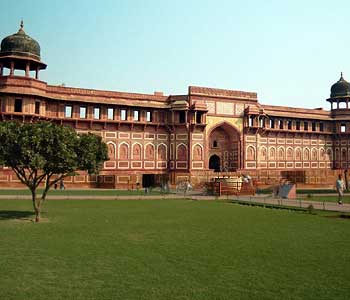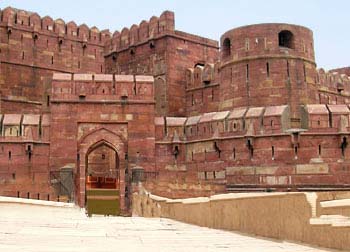Agra Fort
The majestic citadel 'Agra Fort' as the name indicates is located in Agra, Uttar Pradesh. The fort is also called Lal Qila, Fort Rouge and Red fort of Agra. The fort is often described as 'walled palatial city'. Agra Fort dates back to 1565 -1571, the period of Emperor Akbar and his son King Shahjahan. This monument made of red sandstone and standing on the mighty river Yamuna is about 2 km northwest of the more famous sister monument the Taj Mahal.
These days public access to this fort is limited to the southern part only. This area however includes nearly all the buildings that should be of interest for the tourists. The northern area of the fort is being used by the Indian military. The Agra Fort was designated as a UNESCO World Heritage Site in the year 1983.
Architectural splendor of the Agra Fort
The fort holds a premier position in terms of architectural history. An excellent blend of Hindu and Islamic architecture can be noticed here. While most of the decorations are Islamic in tradition, images of dragons, elephants and birds that are featured in the fort instead of patterns of calligraphy clearly indicate Hindu style of architecture. Typical of Mughal architecture, this fort is crescent shaped. The colossal double wall of the fort rises to about 69 ft in height and measures 2.5 km in circumference. The fort contains several splendid mosques and palaces in red sandstone and white marble respectively.
The fort had four gates at the time of its construction. Although the Delhi gate is the grandest and impressive gateway, the Lahore gate which is also known as Amar Singh gate is being used presently. The fort is famous among tourists for its rich palace settings, beautiful halls, profuse carvings on stone, exquisite piers and carved heavy brackets. Persian style stucco paintings in gold and blue hues originally decorated the eastern hall. Later Emperor Shah Jahan replaced it with white marble pavilions covered with intricate inlay work.
Many significant and outstanding buildings were constructed within this glorious fort by Emperor Akbar, Jahangir and Shah Jahan, but few remain today. The multistoried Jahangiri Mahal, Diwan-i-khas, the Mausam Burj, the Moti Masjid and the Diwan-i-Am are all significantly worth mentioning.
Within Agra Fort
The Jehangiri Mahal: This is the first notable building and probably one of the best as the tourist enters the fort. Jehangiri palace was built by Emperor Akbar as a residence for his son Jehangir. This palace housed women of the court dating back to 1570s. The Jehangiri Mahal exhibits Hindu decorative motifs and styles probably indicating the large heartedness of Akbar the Great who embraced all religions. Colorful halls, slender pillared verandahs; heavy stone brackets remind one of the mughal architecture.
The Khas Mahal: A subtle blend of Hindu and Persian style of architecture popularly known as Mughal style can be seen in this Mahal. The Mahal has three pavilions with a fountain opposite the central pavilion overlooking the Yamuna and overlooking the 'Angoori Bagh'- the grape garden with its then flowering beds, hidden lamps and hanging jewels. Of the two pavilions that flank this Mahal, one is made of gold (copper) and the other of red stone. Extensive use of white marble and paintings on the surface indicates that this belonged to Emperor Shah Jahan previously.
Mussaman Burj: This is an octagonal tower which was previously the bedroom of Emperor Shah Jahan for his beloved wife Mumtaz Mahal. Historical accounts reveal that Shah Jahan was imprisoned and kept in this room under house arrest by his son Aurangazeb for last seven years of his life. The Burj is made of delicate marble lattices with ornamental niches for the court ladies to gaze out unseen. The tower of the Burj overlooks River Yamuna and poignant views of the Taj can be had from the top of the tower dome.
Diwan-i-Khas: This is the hall of private audience where the Emperor Shah Jahan met visiting dignitaries. Built in 1635, this hall has marble columns inlaid with semi-precious stones in floral patterns. Two thrones are placed on the terrace of the Diwan-i-Khas one made of white marble and the other one in black slate. The emperor slept in the 'Khas Mahal' and amused himself with his courtiers with angling at the 'Machchhi bhavan', the house of fish. Presently visitors are not allowed into Diwan-i-Khas.
Diwan-i-Am: This is the hall of public audience and Emperor Shah Jahan would listen to the complaints of his subjects in this arcaded hall seated on a Peacock Throne. This hall is noted for its splendour. The hall was made of red sandstone and extremely impressive with its throne alcove made of rich decorated white marble.
The Moti Masjid which is located near the Nagina Masjid is a pearl mosque built in white marble. It is awesome to see this grand mosque with three domes rising above the red sandstone wall.
Sheesh Mahal: Below the Diwan-i-Khas hall and end of the Khas Mahal is the Sheesh Mahal known as 'Glass palace'. This palace as its name indicates is full of mirrors and is believed to be one of the best specimens of glass mosaic decorations in India and Asia. This was where royals dressed themselves in the Mughal period.
The Nagina Masjid or the gem mosque is a private mosque raised by Emperor Shah Jahan for the ladies of his court. The Hammam-i-Shahi which is located right of Diwan-i-Khas is an airy place and attached to the residential quarters used as summer retreat.
Visiting Agra Fort
The Agra Fort is open for visitors from sunrise to sunset. The weather is at its best between the months of November and March in Agra. A number of interesting festivals are celebrated in the city at this time like the famous Taj Mahatsov, the Sharadotsav which is a cultural festival noted for performance by artists from all over India.
Agra is one of the top tourist destinations of India. It is well connected by air, rail and roadways. Several domestic flights link Agra to Delhi, Varanasi and Khajuraho. Several trains from Southern India as well as from Delhi, Gwalior and Jhansi are connected to the Agra railway station. Agra is linked to prominent places like Mathura, Delhi, Gwalior, Jaipur and other by road through deluxe and ordinary bus services.
|

















































